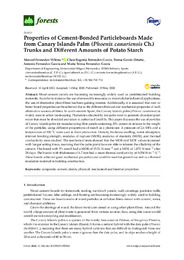Por favor, use este identificador para citar o enlazar este ítem:
https://hdl.handle.net/11000/34585Registro completo de metadatos
| Campo DC | Valor | Lengua/Idioma |
|---|---|---|
| dc.contributor.author | Ferrández-Villena, Manuel | - |
| dc.contributor.author | Ferrandez Garcia, Clara Eugenia | - |
| dc.contributor.author | Garcia-Ortuño, Teresa | - |
| dc.contributor.author | Ferrández García, Antonio | - |
| dc.contributor.author | FERRÁNDEZ, MARÍA TERESA | - |
| dc.contributor.other | Departamentos de la UMH::Ingeniería | es_ES |
| dc.date.accessioned | 2025-01-16T17:34:49Z | - |
| dc.date.available | 2025-01-16T17:34:49Z | - |
| dc.date.created | 2020 | - |
| dc.identifier.citation | Forests | es_ES |
| dc.identifier.issn | 1999-4907 | - |
| dc.identifier.uri | https://hdl.handle.net/11000/34585 | - |
| dc.description.abstract | Wood-cement panels are becoming increasingly widely used as prefabricated building materials. In order to increase the use of renewable resources as materials for industrial applications, the use of alternative plant fibres has been gaining interest. Additionally, it is assumed that new or better board properties can be achieved due to the different chemical andmechanical properties of such alternative sources of fibres. In south-eastern Spain, the Canary Islands palm (Phoenix canariensis) is widely used in urban landscaping. Plantations attacked by red palm weevils generate abundant plant waste that must be shredded and taken to authorised landfills. This paper discusses the use of particles of Canary Islands palm for manufacturing fibre panels containing 20% cement in relation to the weight of the particles, using different proportions of starch as a plasticiser. A pressure of 2.6 MPa and a temperature of 100 C were used in their production. Density, thickness swelling, water absorption, internal bonding strength, modulus of rupture (MOR), modulus of elasticity (MOE), and thermal conductivity were studied. The mechanical tests showed that the MOR and MOE values increased with longer setting times, meaning that the palm particles were able to tolerate the alkalinity of the cement. The board with 5% starch had a MOR of 15.76 N mm2 and a MOE of 1.872 N mm2 after 28 days. The boards with thicknesses of 6.7 mm had a mean thermal conductivity of 0.054W m1 K1. These boards achieved good mechanical properties and could be used for general use and as a thermal insulation material in building construction. | es_ES |
| dc.format | application/pdf | es_ES |
| dc.format.extent | 12 | es_ES |
| dc.language.iso | eng | es_ES |
| dc.publisher | MDPI | es_ES |
| dc.relation.ispartofseries | 11 | es_ES |
| dc.relation.ispartofseries | 5 | es_ES |
| dc.rights | info:eu-repo/semantics/openAccess | es_ES |
| dc.rights | Attribution-NonCommercial-NoDerivatives 4.0 Internacional | * |
| dc.rights.uri | http://creativecommons.org/licenses/by-nc-nd/4.0/ | * |
| dc.subject | composite | es_ES |
| dc.subject | cement | es_ES |
| dc.subject | starch | es_ES |
| dc.subject | physical | es_ES |
| dc.subject | mechanical and thermal properties | es_ES |
| dc.subject.other | CDU::6 - Ciencias aplicadas::62 - Ingeniería. Tecnología | es_ES |
| dc.title | Properties of Cement-Bonded Particleboards Made from Canary Islands Palm (Phoenix canariensis Ch.) Trunks and Different Amounts of Potato Starch | es_ES |
| dc.type | info:eu-repo/semantics/article | es_ES |
| dc.relation.publisherversion | https://doi.org/10.3390/f11050560 | es_ES |

Ver/Abrir:
2020.- Forests. Properties of Cement-Bonded.pdf
778,48 kB
Adobe PDF
Compartir:
 La licencia se describe como: Atribución-NonComercial-NoDerivada 4.0 Internacional.
La licencia se describe como: Atribución-NonComercial-NoDerivada 4.0 Internacional.
.png)